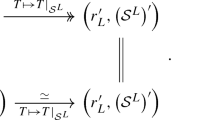Abstract
Let \(G=G(k)\) be a connected reductive group over a p-adic field k. The smooth (and tempered) complex representations of G can be considered as the nondegenerate modules over the Hecke algebra \({\mathcal {H}}={\mathcal {H}}(G)\) and the Schwartz algebra \({\mathcal {S}}={\mathcal {S}}(G)\) forming abelian categories \({\mathcal {M}}(G)\) and \({\mathcal {M}}^t(G)\), respectively. Idempotents \(e\in {\mathcal {H}}\) or \({\mathcal {S}}\) define full subcategories \({\mathcal {M}}_e(G)= \{V : {\mathcal {H}}eV=V\}\) and \({\mathcal {M}}_e^t(G)= \{V : {\mathcal {S}}eV=V\}\). Such an e is said to be special (in \({\mathcal {H}}\) or \({\mathcal {S}}\)) if the corresponding subcategory is abelian. Parallel to Bernstein’s result for \(e\in {\mathcal {H}}\) we will prove that, for special \(e \in {\mathcal {S}}\), \({\mathcal {M}}_e^t(G) = \prod _{\Theta \in \theta _e} {\mathcal {M}}^t(\Theta )\) is a finite direct product of component categories \({\mathcal {M}}^t(\Theta )\), now referring to connected components of the center of \({\mathcal {S}}\). A special \(e\in {\mathcal {H}}\) will be also special in \({\mathcal {S}}\), but idempotents \(e\in {\mathcal {H}}\) not being special can become special in \({\mathcal {S}}\). To obtain conditions we consider the sets \(\mathrm{Irr}^t(G) \subset \mathrm{Irr}(G)\) of (tempered) smooth irreducible representations of G, and we view \(\mathrm{Irr}(G)\) as a topological space for the Jacobson topology defined by the algebra \({\mathcal {H}}\). We use this topology to introduce a preorder on the connected components of \(\mathrm{Irr}^t(G)\). Then we prove that, for an idempotent \(e \in {\mathcal {H}}\) which becomes special in \({\mathcal {S}}\), its support \(\theta _e\) must be saturated with respect to that preorder. We further analyze the above decomposition of \({\mathcal {M}}_e^t(G)\) in the case where G is k-split with connected center and where \(e = e_J \in {\mathcal {H}}\) is the Iwahori idempotent. Here we can use work of Kazhdan and Lusztig to relate our preorder on the support \(\theta _{e_J}\) to the reverse of the natural partial order on the unipotent classes in G. We finish by explicitly computing the case \(G=GL_n\), where \(\theta _{e_J}\) identifies with the set of partitions of n. Surprisingly our preorder (which is a partial order now) is strictly coarser than the reverse of the dominance order on partitions.
Similar content being viewed by others
References
Aubert, A.-M., Baum, P., Plymen, R., Solleveld, M.: The principal series of \(p\)-adic groups with disconnected centre. Preprint (2014)
Barbasch, D., Moy, A.: A unitarity criterion for \(p\)-adic groups. Invent. Math. 98, 19–37 (1989)
Borel, A.: Linear Algebraic Groups, 2nd edn. Springer, New York (1991)
Borel, A.: Automorphic \(L\)-functions. In: Borel, A., Casselmann, W. (eds.) Automorphic Forms, Representations, and \(L\)-Functions. Proc. Symp. Pure Math. 33(2), 27–61. American Math. Soc. (1979)
Borel, A., Tits, J.: Groupes réductifs. Publ. Math. IHES 27, 55–151 (1965)
Borel, A., Wallach, N.: Continuous cohomology, discrete subgroups, and representations of reductive groups. Annals Math. Studies, vol. 94. Princeton University Press (1980)
Bourbaki, N.: Groupes et algèbres de Lie. Masson 1981 (1990)
Brylawski, T.: The lattice of integer partitions. Discrete Math. 6, 201–219 (1973)
Bushnell, C.J., Kutzko, P.C.: Smooth representations of reductive \(p\)-adic groups: structure theory via types. Proc. Lond. Math. Soc. 77, 582–634 (1998)
Carter, R.: Finite Groups of Lie Type. Wiley, New York (1993)
Cartier, P.: Representations of \({\mathfrak{p}}\)-adic groups: a survey. In: Borel, A., Casselman, W. (eds.) Automorphic Forms, Representations, and \(L\)-Functions. Proc. Symp. Pure Math. 33(1), 111–155. American Math. Soc. (1979)
Casselman, W.: Introduction to the theory of admissible representations of \(\wp \)-adic reductive groups. Preprint (1995)
Dat, J.-F.: Caractères à valeurs dans le centre de Bernstein. J. Reine Angew. Math. 508, 61–83 (1999)
Haines, T., Kottwitz, R., Prasad, A.: Iwahori–Hecke algebras. J. Ramanujan Math. Soc. 25(2), 113–145 (2010)
Kazhdan, D., Lusztig, G.: Proof of the Deligne–Langlands conjecture for Hecke algebras. Invent. Math. 87, 153–215 (1987)
Rodier, F.: Représentations de \({\rm GL(n,k)}\) où \(k\) est un corps \({\mathfrak{p}}\)-adique. Sém. Bourbaki, Exp. 587 (1981/82)
Schneider, P., Zink, E.-W.: The algebraic theory of tempered representations of \(p\)-adic groups, part I: parabolic induction and restriction. J. Inst. Math. Jussieu 6, 639–688 (2007)
Schneider, P., Zink, E.-W.: The algebraic theory of tempered representations of \(p\)-adic groups, part II: projective generators. Geom. Funct. Anal. 17, 2018–2065 (2008)
Schneider, P., Stuhler, U., Zink, E.-W.: \(K\)-types for the tempered components of a \(p\)-adic general linear group. With an appendix: the definition of the tempered category. J. Reine Angew. Math. 517, 161–208 (1999)
Silberger, A.: The Langlands quotient theorem for \(p\)-adic groups. Math. Ann. 236, 95–104 (1978)
Springer, T.A.: Linear Algebraic Groups, 2nd edn. Birkhäuser, Boston-Basel-Berlin (1998)
Springer, T.A., Steinberg, R.: Conjugacy classes. In: Seminar on Algebraic Groups and Related Finite Groups, Lect. Notes Math., vol. 131. Springer, pp. 167–266 (1986)
Vigneras, M.-F.: On formal dimensions for reductive \(p\)-adic groups. In: Gelbart, S., Howe, R., Sarnak, P. (eds.) Festschrift in honor of I.I. Piatetski-Shapiro, part I. Israel Math. Conf. Proc. vol. 2, pp. 225–266 (1990)
Waldspurger, J.-L.: La formule de Plancherel pour les groupes \(p\)-adiques, d’après Harish–Chandra. J. Inst. Math. Jussieu 2, 235–333 (2003)
Zelevinsky, A.: Induced representations of reductive \({\mathfrak{p}}\)-adic groups II. On irreducible representations of \({\rm GL}(n)\). Ann. Sci. ENS 13, 165–210 (1980)
Author information
Authors and Affiliations
Corresponding author
Additional information
For the 70th birthday of Joseph Bernstein
Rights and permissions
About this article
Cite this article
Schneider, P., Zink, EW. Tempered representations of p-adic groups: special idempotents and topology. Sel. Math. New Ser. 22, 2209–2242 (2016). https://doi.org/10.1007/s00029-016-0274-6
Published:
Issue Date:
DOI: https://doi.org/10.1007/s00029-016-0274-6




